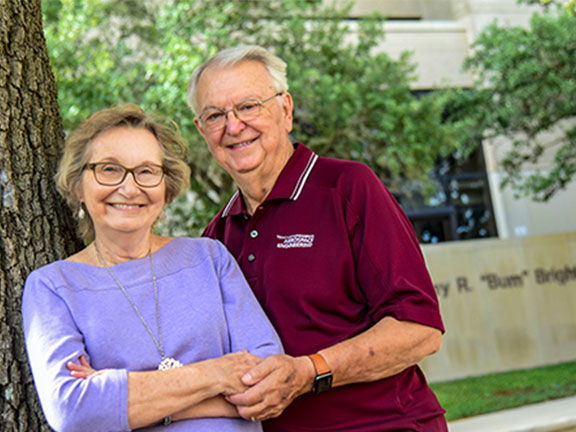
Staring up at the model airplanes hanging from the ceiling of his childhood bedroom, Dr. Walter Haisler ’67 dreamed of attending the U.S. Air Force Academy and becoming a pilot. Little did he know that his life’s course would be redirected to Texas A&M University, where he would work in the aerospace engineering department for 41 years and spend more than 12 of them as department head.
“I always wanted to attend the Air Force Academy when I was growing up,” Walter said. “But, as things went, I was not accepted. When a friend of mine planned to attend Texas A&M, I decided to join him.”
As newlyweds, Walter and his wife, Delores, moved to College Station in 1964. While Delores worked as a bookkeeper in one of the campus dining halls, Walter pursued his bachelor’s degree in aerospace engineering. “At that time, I never had any intention of becoming a faculty member,” he said. “I had my sights set on working for an aeronautical company after graduation, but Dr. James Stricklin asked me to assist him with his research. The rest is history!” Under his mentorship, Walter completed his master’s in 1968 and Ph.D. in 1970.
A New Path
About a year before finishing his doctorate, Walter was asked to consider joining the Texas A&M aerospace faculty. “By this time, I had realized my passion for teaching and research, and it was clear that the university presented many new opportunities,” he said. “It is an honor to have been part of aerospace’s growth from seven faculty members in 1970 to more than 30 when I retired in 2011.”
In his early years in the department, Walter contributed to the burgeoning excitement of space exploration and advancements in flight by researching ways to prevent the Apollo spacecraft from burning to a crisp upon re-entry into Earth’s atmosphere.
Later, as head of the aerospace department, he launched the 1985 initiative to construct the Harvey R. “Bum” Bright Building to provide new facilities more conducive to the department’s research, and during the next decade, the department added a dozen faculty with particular emphasis on space-related research. Walter also encouraged the development of the nationally-recognized Aerothermochemistry and Hypersonics Laboratory. Located at Easterwood Airport, the lab allows faculty to perform leading research on high-speed gas dynamics, unsteady flows, and flows with thermal and chemical non-equilibrium effects.
Some of his most memorable moments, however, came from interacting with students. “I love meeting or hearing from students who I taught over the years,” he said. “They often tell me what they learned that was most important to them and that they’re thankful for my focus on teaching principles rather than problem solutions. I’ve even received a couple thank-yous for being a tough grader!”
Future Flights

Having served the aerospace department for so long, Walter knows its challenges well. As he and Delores began working on their estate plans, they realized their ability to make a lasting impact with their resources. When they created their will, they made sure to provide for the needs of their children first, and then Walter and Delores’ estate will fund an endowment for aerospace’s department head chair.
“Overall, my challenge as department head was to direct aerospace onto the path of national recognition,” Walter said. “With an endowed chair, the department can recruit a candidate of the highest caliber who can use the chair funds for both departmental and professional development.”
Walter and Delores hope that their gift allows future department heads to foster growth and a strong work ethic among professors and students. “It has been my pleasure to serve Texas A&M, particularly the aerospace department, to have seen it grow in stature and reputation, and to have been a part of the education of many thousands of engineering students,” Walter said. “I want the department to continue to be the best undergraduate and graduate educational program in the nation, and I hope our gift offers the resources necessary to do so.”
How to Give
This story, written by Morgan Knobloch '20 with the Texas A&M Foundation, originally appeared on the Texas A&M Foundation's website.